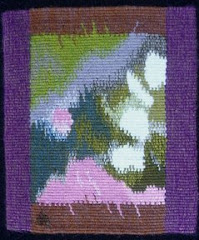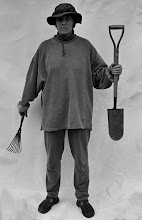Arriving at the Basel Historical Museum, I was disappointed to find that the entire downstairs, including most of the renowned tapestry collection, was in storage due to renovations.
There were a few tapestries in the gallery with all the gorgeous carved wood altars and religious figures. In this image you can see “The Effusion of the Holy Spirit” tapestry below the altarpiece.
I was impressed with how the tapestries were displayed: behind glass (but not far behind), so they could be down low, and people can get up very close to them. To preserve them from too much light, they have mechanical shades; you have to push a button to open the shade, which then closes again automatically in about 2 minutes. Of course that meant I had to keep opening them so I could examine the tapestries closely. The only problem is that you have no idea a tapestry is there, unless you happen to see someone opening the shade!
These are Swiss tapestries, woven in Basel and Aargau from 1480-1490. The tapestry pictured above is described as a “Pentecostal Altar Tapestry,” and I’m thinking they are all altar tapestries. They all feature religious figures standing in a row facing forwards. As for weaving style, I did not see any demi-duite, and what little hatching there I saw was for pattern or representation, and not for shading.
The backgrounds look like old silk velvet and brocade fabric patterns, and the catalog points out that it was common to have these types of fabrics hanging on walls, so they make an obvious background. The author says that the “representation of a textile within a textile was very popular with tapestry weavers…”
Along the bottom most of them have a few wildflowers, as if referring to the Mille Fleurs style, only instead of 1000 flowers, there are only 5, or 10 or at most 20.
One of the tapestries has missing weft in exactly the shapes of the feet, then I noticed that the remaining foot is black. I remembered the tapestry conservator at the Isabella Stewart Gardner Museum in Boston telling us that they often used iron mordant to make black dyes, and that the iron rotted the weft.
In general these tapestries are in good condition for their age, although like many old tapestries, the yellows have faded, leaving lots of blue areas that used to be green. They are fairly small, most about 5 ft wide by 3 feet tall, although one, Three Scenes from the Life of Christ is bigger, about 9 feet wide.
There are no borders. The sett seemed to be about 17 epi and the wefts are quite fine.
I love the way they wove hair. In the Pentecostal tapestry they all look like they have dreadlocks!
One guy has locks of about 3 different colors.
In the Resurrection tapestry, they did a lovely job on Jesus’ hair and beard, even on the towel being held by St Veronica, with the image of Jesus’ face imprinted.
There is a lovely catalog of the permanent collections, with photos, (and including a few tapestries) and when I asked about buying it, I was told that if I filled out a survey I could have it for free! Then they had a small, inexpensive ($15) book of their tapestries, with photos, so of course I bought it. The title is “The Ancient Tapestries in the Basle Historical Museum,” text by Hans Lanz, Basel 1985. It’s more often cited by its German title “Die alten Bildteppiche im Historischen Museum Basel.” The book actually includes text in German, French and English in the same volume.
From the catalog, I can see that I’ll have to come back someday to see the rest of the collection. “Noblemen and Women Hawking,” “Depiction of the Power of Women,” and the charming “Wild Woman with Unicorn in a Forest Clearing,” which has the adorable brown unicorn, and the wild woman wearing a blue fur dress with holes in it for her bare breasts to stare out of.
Tapestries I saw, with apologies for the photos; the tapestries are behind glass, so there are reflections.
Five Women Saints:
St Barbara, St Agnes, St Dorothy, St Mary Magdalene and St Verena. (below left)
Mary Magdalene and St Veronica (holding shroud with image of Christ’s face) and Two Angels. (below right)
Effusion of the Holy Spirit.
Mary and Holy Ghost (as dove) and 11 apostles. Pentecostal Altar Tapestry (below left)
Crucifixion, with Mary, John the Evangelist, St Francis of Assissi and St Clara. (Sorry, no photo of this one, click here instead)
Three Scenes from the Life of Christ (below)











5 comments:
WOW!! THANKS JAN!! What a treat.
Tommye
Thank you Jean, it is such a feast!
Awesome tour for us, Jan! Thanks so much! You should set up a tour for us all.... sign me up!
I'm so glad you enjoyed these. Nobody in the US seems to know that there are so many wonderful tapestries in Switzerland, so I'm happy to spread the word.
Loved the photo's especially the hair. Swiss tapestry of that period is more related to German tapestry-fewer hatches and hachures, more use of pulled tapestry, more modern cartoon-comic book style like, etc. I love tapestries from Northern Europe they are so different from French and lowland tapestries of that period. I ahve sen some remarkable photos of the wildwomen tapestry. It's incrediable as are all wildman tapestries.
kathe
Post a Comment